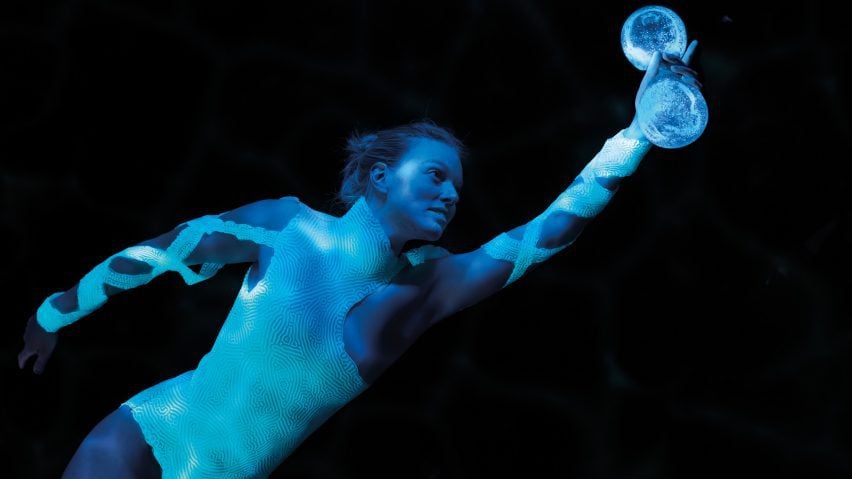Designer Christopher Bellamy has sought to marry biotechnology and craft in a series of works that combine traditional knowledge from artisans in the Pacific Islands with a new material made from bioluminescent algae.
Titled Lucid Life, or Marama Ora in Tahitian, Bellamy's research project saw him create three different objects – a drum, a swimsuit and an ornamental neckpiece – working together with artists and makers on Mo'orea in French Polynesia.
The objects are all made from a material containing living algae that lights up in response to touch or movement, which Bellamy says has the effect of making whoever is using or wearing the objects feel more connected with the natural world.
The British designer describes Mo'orea as home to both a strong Polynesian indigenous population and a uniquely diverse ecosystem, including on the level of microorganisms, that attracts scientists from all over the world.
He first travelled to the island drawn by his interest in sustainability and said he developed ties to the place and people with no project in mind.
However, as a masters student in Biodesign at Central Saint Martins, he soon saw an opportunity to apply this emerging design approach, which involves working with living organisms such as bacteria, fungi or plants and animals, as a way to share knowledge between the scientific and indigenous communities.
"Living materials' ability to grow, adapt and heal has been used symbiotically by humans for thousands of years," said Bellamy. "However, they are now replaced by the more reliable and repeatable inert materials which dominate our day-to-day lives."
In particular, Bellamy worked closely with artist and researcher Tokainiua Jean-Daniel Devatine, who is also deputy director of the Centre des Métiers d'Art de la Polynésiefrançaise. The two designed the neckpiece, which combines the bioluminescent algae material with intricate mother of pearl fragments cut by Devatine.
Their shapes are inspired by voronoi patterns, cell-like tessellations found commonly in nature, and the piece is intended to illuminate with the user's movement or breath.
The swimsuit came about through a collaboration with cultural educator Tekoui 'Jérémie' Tamari and was inspired by his stories of nightime spear fishing, and the family and friends he had lost to this dangerous profession.
Its design tries to capture Tamari's philosophy of symbiosis and interconnection with nature, while also providing a protective function at night.
The drum was created with Hinatea and Moé Colombani, both experts in making a traditional cloth called Tapa, and features the algae material stretched over the top in place of the usual fish skin. The material lights up as the drum is tapped.
Bellamy created the bases for all of the objects with his collaborators on Mo'orea, then added the algae material at home in London, where he had access to the facilities of the Francis Crick Institute for biomedical research.
Throughout the design process, Bellamy said he endeavoured to be culturally sensitive and to counteract the level of power he had in the situation.
"I was very aware throughout the whole process that I was a white European male arriving in this island community, and very aware of mistakes that have been made in the past," Bellamy told Dezeen.
"It made me particularly cautious of the whole process of collaboration and making sure that it was really, truly equal, and that we were coming to this from a place of mutual benefit."
He said that he let his collaborators take the lead and tried "not being too attached to an outcome", even when this meant he didn't get his way.
For instance, the drum was originally patterned with a design by one of Hinatea Colombani's friends, but they decided they were not comfortable for it to leave Tahiti or be used in the project. Instead, they agreed that a new design could be created based on their work, which Bellamy programmed custom software to do, to remove more of his control over the process.
As well as thinking about intercultural collaboration in the project, Bellamy also thought about interspecies collaboration – an emerging approach in design that often sees designers try to empathise with other species.
In all of the Lucid Life objects, the goal is to keep the algae alive and thriving for as long as possible. They live within a gel that is encapsulated in a permeable membrane, which Bellamy likens to a Gore-Tex for algae.
Although some his early algae colonies died quickly, he has learned to keep them alive for long enough that the Lucid Life objects retained their bioluminescence for over six months. In the process, he found himself relating to the algae.
"They need about eight hours of sleep and 12 hours of daylight," he said. "They need regular movement and exercise. They kind of need the same things as me."
Overall, Bellamy is a big advocate for living materials – he used to work as an engineer on electric cars and recyclable footwear but decided they only represented incremental improvements in sustainability, and that a more radical approach was needed.
For this reason, he thinks biotechnology and craft are "a perfect match" and would rather see this kind of design applied in small, localised, day-to-day processes – like baking bread or brewing beer – rather than scaled up to an industrial level that replicates environmental harms.
"Biotechnology is this amazing process that can be incredibly distributed," he said.
Bellamy's work follows in the footsteps of designers like Thomas Thwaites, who spent three days living as a goat in an attempt to shift how we think of non-human creatures.

